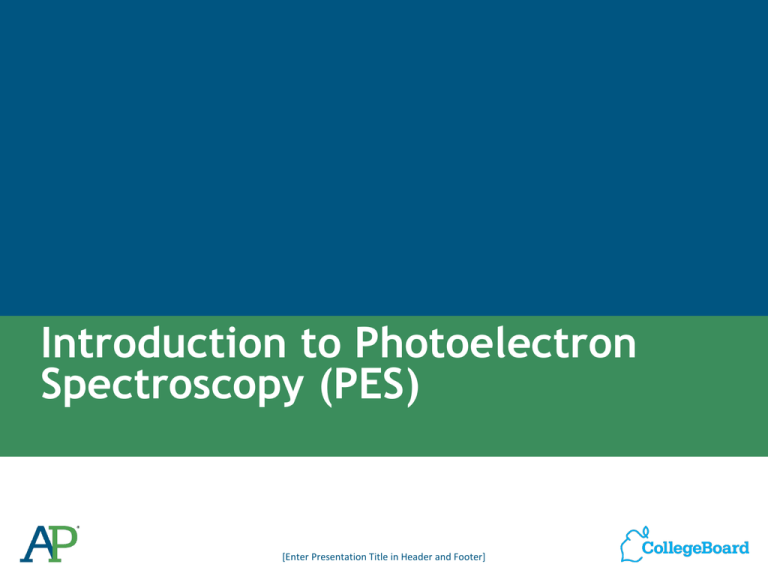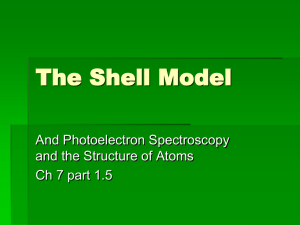Intro to PES - Mrs. Nielsen Science
advertisement

Introduction to Photoelectron Spectroscopy (PES) [Enter Presentation Title in Header and Footer] Why a webcast on PES? Chemists rely heavily on various methods of spectroscopy to understand the structure of atoms and molecules that are too small to see directly Photoelectron Spectroscopy (PES) is a powerful instrumental tool for probing the electronic structure of any of the naturally-occurring elements, as well as materials that contain mixtures of these elements Image Source: SPECS GmbH Various Models of the Atom + + - - + + - + -+ -+ + Dalton Thomson - - ++ + ++++ - + - - + +++++++ Rutherford Bohr Image sources: http://library.thinkquest.org/13394/angielsk/athompd.html http://abyss.uoregon.edu/~js/21st_century_science/lectures/lec11.html http://mail.colonial.net/~hkaiter/astronomyimages1011/hydrogen_emis_spect.jpg http://upload.wikimedia.org/wikipedia/commons/9/97/A_New_System_of_Chemical_Philosophy_fp.jpg Further refinements to these models have occurred with new experimental results 5f 7s 6p 5d 6s 5p 4d 5s 4p 4s 3p 3s 2p 2s 1s 3d 4f 1s 2s 3s 4s 5s 6s 7s 8s 2p 3p 4p 5p 6p 7p 3d 4d 4f 5d 5f 6d But not all elements ‘follow the rules’ 1s 2s 3s 24 29 [Ar]4s13d5 [Ar]4s13d10 Cr Cu Chromium Copper 52.00 63.55 1s 2p 3p 4s 3d 4p 5s 4d 5p 6s 5d 6p 7s 6d 7p 4f 5f How do we know? - hν - + Ionization Energy Image source: http://chemistry.beloit.edu/stars/images/IEexpand.gif Image source: Dayah, Michael. “Dynamic Periodic Table.” Accessed Sept. 5, 2013. http://ptable.com/#Property/Ionization Ionization Energy Element IE1 IE2 IE3 IE4 IE5 IE6 IE7 Na 495 4,560 Mg 735 1,445 7,730 Al 580 1,815 2,740 11,600 Si 780 1,575 3,220 4,350 16,100 P 1,060 1,890 2,905 4,950 6,270 21,200 S 1,005 2,260 3,375 4,565 6,950 8,490 27,000 Cl 1,255 2,295 3,850 5,160 6,560 9,360 11,000 Ar 1,527 2,665 3,945 5,770 7,230 8,780 12,000 LO 1.5 - The student is able to explain the distribution of electrons in an atom or ion based upon data. LO 1.6 - The student is able to analyze data relating to electron energies for patterns or relationships. How do we probe further into the atom? 𝑬 = 𝒉𝝂 Radiation Type ν E Aspects Probed Microwaves 109 – 1011 Hz 10-7 – 10-4 MJ/mol Molecular rotations Infrared (IR) 1011 – 1014 Hz 10-4 – 10-1 MJ/mol Molecular vibrations Visible (ROYGBV) 4x1014 – 7.5x1014 Hz 0.2 - 0.3 MJ/mol Ultraviolet (UV) 1014 – 1016 Hz 0.3 – 100 MJ/mol 1016 – 1019 Hz 102 – 105 MJ/mol X-ray hν - - - - 11+ hν - - - Valence electron transitions in atoms and molecules Valence electron transitions in atoms and molecules Core electron transitions in atoms 𝑬 = 𝒉𝝂 IE1 = 495 kJ/mol IE1 = 0.495 MJ/mol Removing Core Electrons - - - - 11+ hν - - - - 𝑬 = 𝟏𝟎𝟑. 𝟑 𝑴𝑱/𝒎𝒐𝒍 𝑬 = 𝟏. 𝟎𝟑𝟑 ∙ 𝟏𝟎𝟖 𝑱/𝒎𝒐𝒍 𝑬 𝟏. 𝟎𝟑𝟑 ∙ 𝟏𝟎𝟖 𝑱/𝒎𝒐𝒍 𝝂= = 𝒉 𝟔. 𝟔𝟐𝟔 ∙ 𝟏𝟎−𝟑𝟒 𝑱 ∙ 𝒔 𝝂 = 𝟏. 𝟓𝟓𝟗 ∙ 𝟏𝟎𝟒𝟏 𝒎𝒐𝒍−𝟏 ∙ 𝒔−𝟏 𝟏 𝒎𝒐𝒍 𝝂 = 𝟏. 𝟓𝟓𝟗 ∙ 𝟏𝟎𝟒𝟏 𝒎𝒐𝒍−𝟏 ∙ 𝒔−𝟏 × 𝟔. 𝟎𝟐𝟐 ∙ 𝟏𝟎𝟐𝟑 𝒆− 𝝂𝒎𝒊𝒏 = 𝟐. 𝟓𝟗 ∙ 𝟏𝟎𝟏𝟕 𝑯𝒛 Radiation Type X-ray ν 1016 – 1019 Hz E 102 – 105 MJ/mol Aspects Probed Core electron transitions in atoms Removing Core Electrons hν - - - - 11+ hν - - - 𝑬𝟏𝒔𝒕 = 𝟏𝟎𝟑. 𝟑 𝑴𝑱/𝒎𝒐𝒍 𝑬𝟐𝒏𝒅 = 𝟑 − 𝟔 𝑴𝑱/𝒎𝒐𝒍 Any frequency of light that is sufficient to remove electrons from the 1st shell can remove electrons from any of the other shells. 𝒉𝝂 = IE + KE PES Instrument Image Source: SPECS GmbH, http://www.specs.de/cms/front_content.php?idart=267 Supporting Resources (cont.) Image Source: Shen Laboratory, Stanford University and SLAC National Accelerator Laboratory http://arpes.stanford.edu/facilities_ssrl.html Image source: Inna M Vishik http://www.stanford.edu/~ivishik/inna_vishik_fil es/Page452.htm Kinetic Energy Analyzer X-ray or UV Source 6.26 0.52 Binding Energy (MJ/mol) 3+ 3+ 3+ 3+ 3+ 3+ 3+ 3+ 3+ 3+ 3+ 3+ 3+ 3+ 3+ 3+ 3+ 3+ 3+ Kinetic Energy Analyzer X-ray or UV Source Li 6.26 0.52 Binding Energy (MJ/mol) Boron 1.36 0.80 19.3 Binding Energy (MJ/mol) 5+ 5+ 3+ 3+ 5+ 5+ 3+ 5+ 3+ 5+ 5+ 3+ 3+ 5+ 3+ 5+ 3+ 5+ 5+ 3+ 5+ 3+ 3+ 5+ 3+ 5+ 5+ 3+ 3+ 5+ 5+ 3+ 5+ 3+ 5+ 3+ Analyzing Data from PES Experiments Relative Number of Electrons Analyzing data from PES 2p 2.0 1s 2s 84.0 4.7 90 80 70 60 50 40 30 20 10 Binding Energy (MJ/mol) Which of the following elements might this spectrum represent? (A)He (B)N (C)Ne (D)Ar 0 Relative Number of Electrons Analyzing data from PES 2p6 7.9 1s2 2s2 3s2 3p1 151 12.1 1.09 0.58 100 10 1 Binding Energy (MJ/mol) Given the spectrum above, identify the element and its electron configuration: (A)B (B)Al (C)Si (D)Na Real Spectrum Auger Transitions - - - - 11+ hν - - - Real Spectrum Intensity (x105 counts/s) 4 3.5 3 2.5 2 1.5 1 .5 0 Intensity (x103 counts/s) Copper vs. Chromium 6 5 4 3 2 1 0 Mixtures of Elements 4 Intensity (x105 counts/s) 3.5 3 2.5 2 1.5 1 0.5 100 90 80 70 60 50 40 30 Binding Energy (MJ/mol) 20 10 0 PES Sample Questions Sample Question #1 Relative Number of Electrons Which element could be represented by the complete PES spectrum below? 100 10 1 0.1 Binding Energy (MJ/mol) (A) Li (B) B (C) N (D) Ne Sample Question #2 Intensity Which of the following best explains the relative positioning and intensity of the 2s peaks in the following spectra? Li 12 10 8 6 4 Binding Energy (MJ/mol) 2 0 Intensity 14 Be 14 (A) (B) (C) (D) 12 10 8 6 4 Binding Energy (MJ/mol) 2 0 Be has a greater nuclear charge than Li and more electrons in the 2s orbital Be electrons experience greater electron-electron repulsions than Li electrons Li has a greater pull from the nucleus on the 2s electrons, so they are harder to remove Li has greater electron shielding by the 1s orbital, so the 2s electrons are easier to remove Sample Question #3 Given the photoelectron spectra above for phosphorus, P, and sulfur, S, which of the following best explains why the 2p peak for S is further to the left than the 2p peak for P, but the 3p peak for S is further to the right than the 3p peak for P? 13.5 1.06 208 18.7 1.95 Phosphorus P MJ/mol 16.5 1.00 239 22.7 Binding Energy Sulfur S 2.05 MJ/mol (A) S has a greater effective nuclear charge than P, and the 3p sublevel in S has greater electron repulsions than in P. (B) S has a greater effective nuclear charge than P, and the 3p sublevel is more heavily shielded in S than in P. (C) S has a greater number of electrons than P, so the third energy level is further from the nucleus in S than in P. (D) S has a greater number of electrons than P, so the Coulombic attraction between the electron cloud and the nucleus is greater in S than in P. Sample Question #4 Intensity (c/s) Looking at the complete spectra for Na and K below, which of the following would best explain the relative positioning of the 3s electrons? Na 105 90 75 60 45 Binding Energy (MJ/mol) 30 15 0 Intensity (c/s) 130 K 400 350 300 250 200 150 Binding Energy (MJ/mol) 100 50 0 Sample Question #4a 4 (A) (B) (C) (D) 3.5 3 Na-3s K-3s Intensity (c/s) Looking at the spectra for Na and K below, which of the following would best explain the difference in binding energy for the 3s electrons? 2.5 2 1.5 Binding Energy (MJ/mol) 1 0.5 K has a greater nuclear charge than Na K has more electron-electron repulsions than Na Na has one valence electron in the 3s sublevel Na has less electron shielding than K 0 Sample Question #4b 4 (A) (B) (C) (D) 3.5 3 Na-3s K-3s Intensity (c/s) Looking at the spectra for Na and K below, which of the following would best explain the difference in signal intensity for the 3s electrons? 2.5 2 1.5 Binding Energy (MJ/mol) 1 0.5 K has a greater nuclear charge than Na K has more electron-electron repulsions than Na Na has one valence electron in the 3s sublevel Na has less electron shielding than K 0 Sample Question #5 Intensity (counts/s) Given the photoelectron spectrum below, which of the following best explains the relative positioning of the peaks on the horizontal axis? Image source: http://www.rsc.org/ej/JM/2010/b925409a/b925409a-f2.gif (A) O has more valence electrons than Ti or C, so more energy is required to remove them (B) O has more electron-electron repulsions in the 2p sublevel than Ti and C (C) Ti atoms are present in a greater quantity than O can C in the mixture. (D) Ti has a greater nuclear charge, but the 2p sublevel experiences greater shielding than the 1s sublevel. Sample Question #6 Intensity (c/s) Given the photoelectron spectrum of scandium below, which of the following best explains why Scandium commonly makes a 3+ ion as opposed to a 2+ ion? 0.63 0.77 500 400 300 50 40 30 10 9 8 7 6 5 4 3 2 1 0 Binding Energy (MJ/mol) (A) Removing 3 electrons releases more energy than removing 2 electrons. (B) Scandium is in Group 3, and atoms only lose the number of electrons that will result in a noble gas electron configuration (C) The amount of energy required to remove an electron from the 3d sublevel is close to that for the 4s sublevel, but significantly more energy is needed to remove electrons from the 3p sublevel. (D) Removing 2 electrons alleviates the spin-pairing repulsions in the 4s sublevel, so it is not as energetically favorable as emptying the 4s sublevel completely. Intensity Quick Check – Can You Now Translate Between These Representations of Mg? 100 10 Binding Energy (MJ/mol) - 4s 3p 3s 2p 2s 1s 1 Mg - - - - 12+ - - - - 1s2 2s2 2p6 3s2 Relative Number of Electrons PES – Data that Shells are Divided into Subshells 2p6 7.9 1s2 2s2 3s2 151 12.1 1.09 3p1 0.58 100 10 1 Binding Energy (MJ/mol) Element IE1 IE2 IE3 IE4 IE5 IE6 IE7 Na 495 4560 Mg 735 1445 7730 Al 580 1815 2740 11,600 Si 780 1575 3220 4350 16,100 P 1060 1890 2905 4950 6270 21,200 S 1005 2260 3375 4565 6950 8490 27,000 Cl 1255 2295 3850 5160 6560 9360 11,000 Ar 1527 2665 3945 5770 7230 8780 12,000 Supporting Resources (cont.) Arizona simulated photoelectron spectra http://www.chem.arizona.edu/chemt/Flash/photoelectron.html Guided inquiry activities on PES • John Gelder (Oklahoma State University) • Moog and Farrell, Chemistry: A Guided Inquiry • POGIL Books on PES technical specs • Van der Heide, Paul. X-Ray Photoelectron Spectroscopy: An Introduction to Principles and Practices. New Jersey: John Wiley & Sons, Inc, 2012. • Ellis, Andrew M., Miklos Feher, and Timothy Wright. Electronic and Photoelectron Spectroscopy: Fundamentals and Case Studies. New York: Cambridge University Press, 2005. Take Away You should now feel confident Explaining how data informs our understanding of the atom Using PES and experimental evidence to build mental models of atomic structure Explaining how a PES instrument collects data and how to analyze spectra







